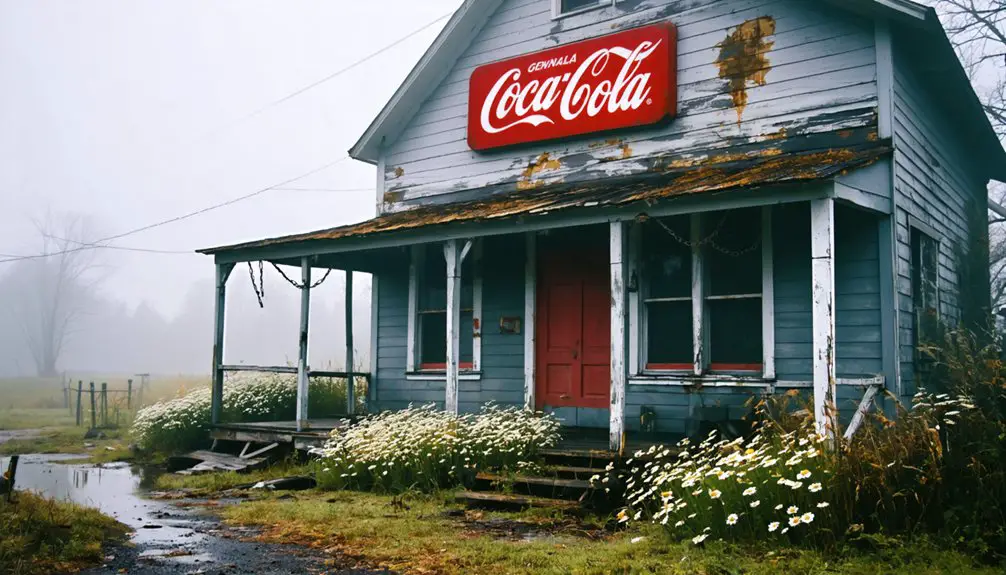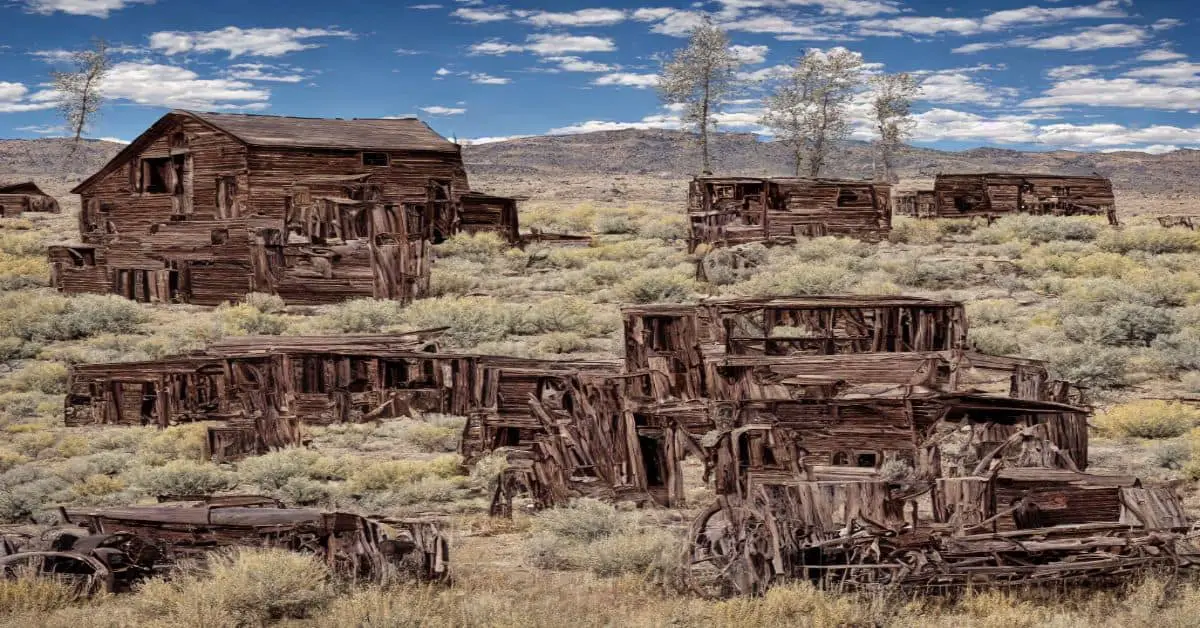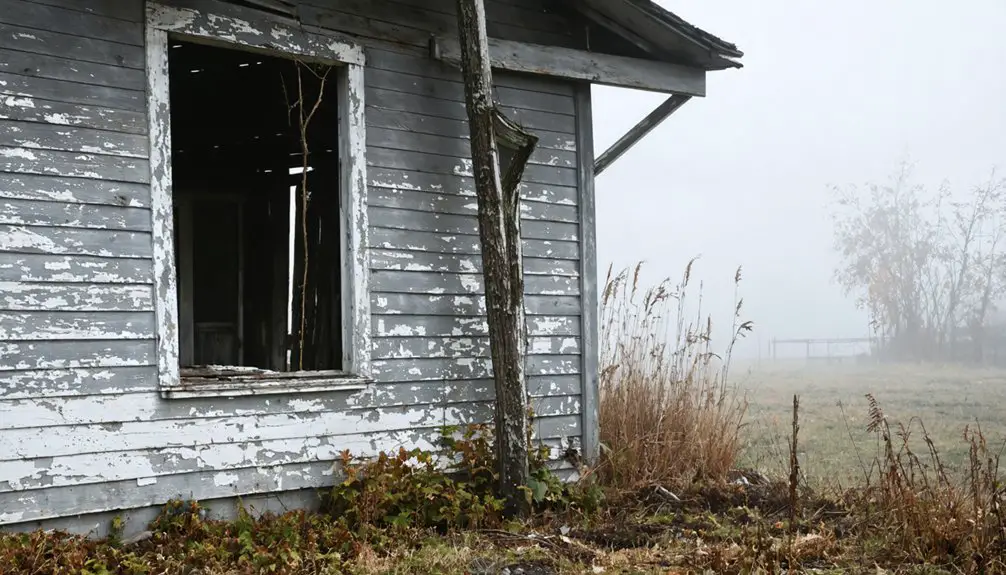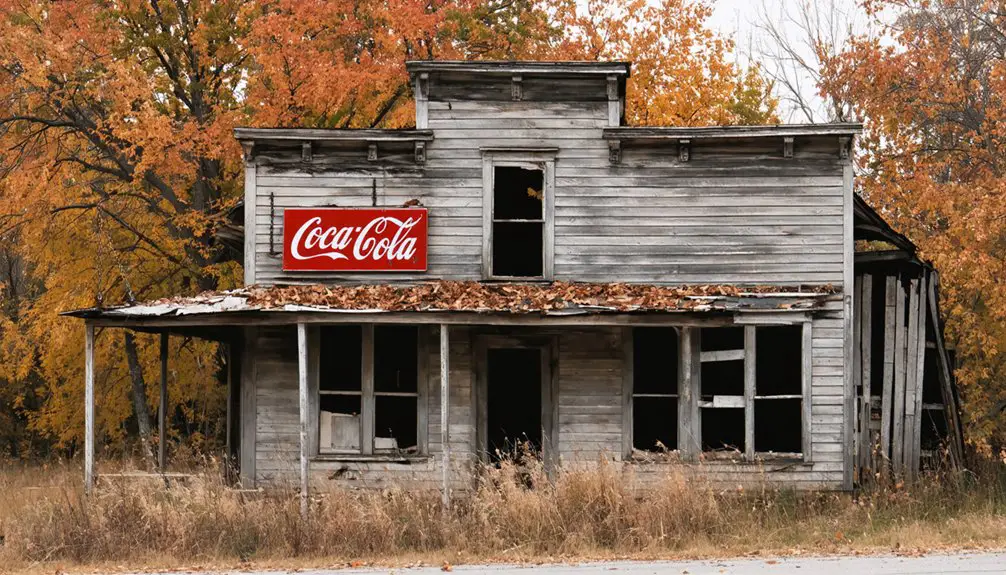You’ll discover Tunk nestled in Michigan’s wilderness, a ghost town born from the late 1800s lumber boom. This once-bustling settlement thrived alongside the Flint & Pere Marquette Railroad, with sawmills powering its economy. When timber resources dwindled and rail routes changed, Tunk’s significance faded. Today, you’ll find weathered foundations, rusted machinery, and old cemetery markers scattered through the woods – silent witnesses to a fascinating chapter of Michigan’s industrial past.
Key Takeaways
- Tunk was established in late 19th century Michigan during the lumber boom, centered around the Flint & Pere Marquette Railroad operations.
- The town thrived on timber industry and railroad connections until economic decline from depleted resources and reduced rail service.
- Natural disasters, including fires and floods, combined with transportation route changes led to the town’s eventual abandonment.
- Physical remnants include building foundations, mining equipment, religious structures, cemetery markers, and artifacts from the company store.
- Local historical societies actively document Tunk’s legacy through photographs, maps, oral histories, and digital archives.
Historical Origins and Heritage
When Michigan’s lumber and mining industries flourished in the late 19th century, the small settlement of Tunk emerged as one of many resource-driven communities dotting the state’s landscape.
Like many founding myths of Michigan’s ghost towns, Tunk’s name likely came from a local family surname or geographical significance in the area.
You’ll find Tunk’s story closely intertwined with the expansion of the railway system, particularly the Flint & Pere Marquette Railroad, which brought life-sustaining connections to the outside world.
The town’s early settlers established themselves around bustling industrial operations, building sawmills and other facilities that supported the region’s booming resource extraction, much like the historic town of Saro Gordo which yielded $500 million in minerals during its peak.
Local herbalists and explorers added unique character to the community, while general stores served as vibrant social hubs where families gathered to trade goods and stories.
Detroit Lansing & Northern Railroad’s arrival marked the beginning of the town’s decline, shifting traffic and commerce away from established routes.
Life in Early Tunk Settlement
Deep in Michigan’s untamed wilderness, everyday life in early Tunk revolved around tight-knit community bonds and self-reliance. You’d find families living in simple log cabins along rivers and early roads, working together to survive the harsh frontier conditions.
Community gatherings centered around religious services, shared meals, and seasonal celebrations tied to farming cycles. The settlers, mainly composed of English and Scots-Irish immigrants, established the early cultural foundations of the settlement.
From Sunday worship to harvest feasts, the rhythm of early Michigan life flowed through moments of fellowship and celebration.
Social roles were clearly defined – men worked the fields, practiced trades like blacksmithing or carpentry, while women managed homes, preserved food, and crafted textiles. The community maintained good relations with local Native Americans, often trading goods and services.
You’d see children learning in one-room schoolhouses that doubled as social hubs. The community made decisions through town meetings, and neighbors helped neighbors through communal work events.
Trade mainly happened through bartering, and most families grew their own food, raising livestock and tending vegetable gardens for sustenance.
Economic Drivers and Industries
The town of Tunk’s humble frontier life laid the foundation for what would become a booming resource-based economy. You’d have seen timber crews hard at work, felling massive trees and sending them down rail lines to bustling sawmills. The logging industry shaped every aspect of life, from the placement of buildings to the rhythm of daily work.
The region experienced unprecedented wealth during the first copper boom in 1844, though Tunk never directly benefited. Much like Duluth, South Shore & Atlantic rail service once connected neighboring Thomaston, Tunk relied heavily on rail transport for its economic survival.
As logging decline set in due to overharvesting, Tunk’s leaders tried to pivot toward mining shifts happening across Michigan. While some nearby towns struck it rich with copper or iron deposits, Tunk never quite found its mining fortune.
When the timber played out and the railroad began reducing service, the town’s economy couldn’t sustain itself. The stores closed, workers moved west, and Tunk’s once-promising future began to fade.
The Path to Abandonment
As resource depletion tightened its grip on Tunk in the early 1900s, you’d have witnessed a town caught in a perfect storm of decline.
Poor resource management had led to exhausted timber stands and played-out mines, leaving the once-bustling community struggling to maintain its economic foothold. The atmosphere became eerily quiet and empty, a stark contrast to the vibrant days of industry. Much like California’s Cerro Gordo which once produced silver worth millions, Tunk’s mineral wealth eventually ran dry.
The town’s path to abandonment unfolded in three devastating waves:
- The rerouting of major transportation routes isolated Tunk, cutting off essential trade connections.
- A series of natural disasters, including devastating fires and floods, struck when community resilience was already at its lowest.
- Young families began moving away in droves, leaving behind aging residents who couldn’t maintain the town’s deteriorating infrastructure.
Remaining Traces and Structures
Walking through Tunk’s remaining ruins today, you’ll find scattered evidence of its once-thriving community hidden among overgrown vegetation and weathered stone.
You’ll discover crumbling foundations where homes once stood, alongside broken pottery shards and rusted tools that tell stories of daily life. The town’s mining heritage reveals itself through abandoned equipment and scattered industrial remnants. Many historical structures here resemble those of the Champion Mining Company era.
The most well-preserved historical artifacts tend to be the religious structures and cemetery markers. You can trace the outlines of old church foundations, while concrete crosses and headstones still stand as silent witnesses to those who called Tunk home. Like Bell Cemetery, these markers were constructed using concrete from local production.
If you venture deeper into the surrounding woods, you might stumble upon the ruins of the company store and mining operations, now reclaimed by nature but still hinting at the town’s bustling past.
Local Stories and Legends
Lingering deep within Michigan’s folklore, Tunk’s ghostly tales paint a haunting portrait of life and death in this abandoned logging town.
You’ll find stories passed down through generations, often rooted in the town’s tragic 1893 fire and the hardships of early industrial life.
- Locals speak of spectral sightings near old landmarks, where phantom children’s laughter echoes through the trees and mysterious figures appear after sunset.
- You might hear whispers of the half-human creatures that prowl the surrounding forests, leaving unexplained footprints and eerie sounds in their wake.
- Ghost hunters flock to former town sites searching for ghostly encounters, drawn by tales of supernatural phenomena at abandoned bridges and forgotten cemeteries.
These legends, while often embellished, keep Tunk’s memory alive in Michigan’s rich tapestry of ghost town lore.
Legacy and Preservation Efforts
While ghostly tales keep Tunk’s spirit alive, the physical remnants of this once-bustling logging town tell a different story. You’ll find few tangible traces today, as nature has reclaimed most of what settlers left behind.
Like many Michigan ghost towns, Tunk faces significant preservation challenges, with weathering and development threatening what little remains. Local historical societies have worked to document Tunk’s legacy through photographs, maps, and oral histories, though community engagement remains limited.
You might spot the occasional foundation or old road bed if you know where to look, but without formal preservation programs, these clues to the past are slowly vanishing.
Still, Tunk’s story lives on through digital archives and historical compilations, serving as a tribute to Michigan’s dynamic industrial heritage.
Frequently Asked Questions
Are There Any Hazardous Materials or Contaminated Sites Near Tunk?
You won’t find documented hazardous materials or contaminated sites right near Tunk, though there might be minor soil impacts from old logging activities scattered through the surrounding forest areas.
Can Metal Detectors Be Legally Used to Explore Tunk’s Remains?
You’ll need to untangle a web of metal detecting regulations and historical preservation concerns before swinging that detector – get landowner permission and proper permits or risk some mighty unpleasant consequences.
What Wildlife Species Now Inhabit the Abandoned Tunk Area?
You’ll spot diverse wildlife including deer, black bears, coyotes, and bats. Wildlife observation opportunities are abundant, with nearly 200 bird species plus amphibians and reptiles inhabiting the area’s forests and ruins.
Is Camping Allowed on the Former Tunk Townsite Property?
You’ll need to check with local authorities about specific ghost town camping regulations, as there’s no clear public info about camping permissions at this site – standard state land rules likely apply.
How Accessible Is Tunk During Winter Months by Snowmobile?
You’ll find decent snowmobile trails in the area, but you’re gonna want local knowledge and proper winter safety gear since unmarked routes and varying snow conditions make access pretty unpredictable.
References
- https://kids.kiddle.co/List_of_ghost_towns_in_Michigan
- https://www.bigrapidsnews.com/news/article/michigan-ghost-towns-herbalist-big-elk-kept-18102531.php
- https://www.youtube.com/watch?v=7-vjuqiGWJU
- https://smallmr.com/wordpress/a-ghost-town-with-its-own-private-railroad/
- https://en.wikipedia.org/wiki/List_of_ghost_towns_in_Michigan
- https://www.youtube.com/watch?v=c0RvVJfNz7A
- https://www.bigrapidsnews.com/news/article/nirvana-tales-michigan-ghost-town-lake-county-19385382.php
- http://legislature.mi.gov/(S(z3iif0wa3lbrqdvs5zubwqg0))/documents/2017-2018/michiganmanual/2017-MM-P0003-p0019.pdf
- https://en.wikipedia.org/wiki/The_Thumb
- https://www.nps.gov/indu/learn/historyculture/indigenous-peoples-and-early-settlement.htm



